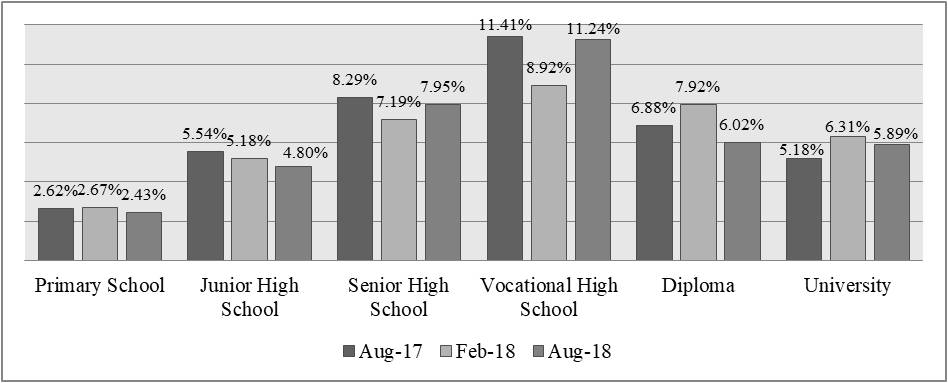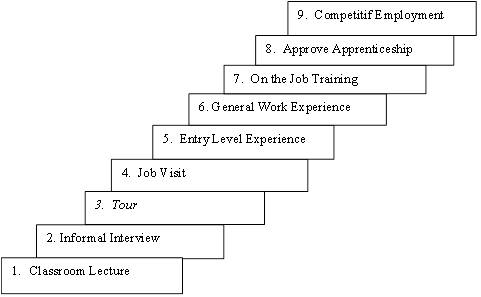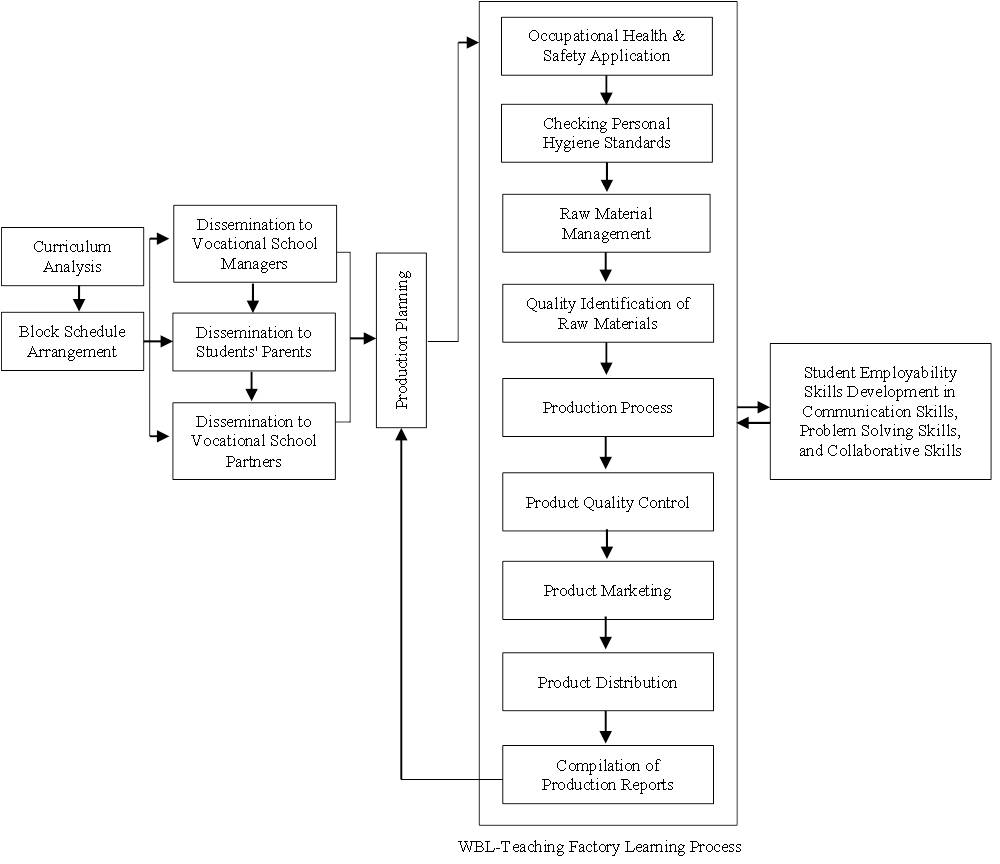Abstract
Employability skills consist of both technical and non-technical skills which are demanded in the world of work. TVET prepares prospective workers who will execute important duties and tasks in industry and business. The mismatch in numbers of trainees in vocational training institutions and placement or internship vacancies available in Indonesia’s industries and businesses is worrisome. The difficulties encountered by vocational trainees in finding an internship opportunity is unsustainable in that some graduates might leave vocational training institutions without possessing market demanded skills. The Teaching Factory Model is a fitting pedagogical approach for training and education. This study focused on the development of employability skills in vocational high school students through the teaching factory model. Teaching factory is one of the work-based learning models in which students learn marketable skills. The research design used in this study was based on congruent triangulation. Three types of employability skills, namely communication, problem-solving, and teamwork were studied. The study results revealed that trainee students can obtain employability skills through various approaches. It was found that work-based learning is fundamental in skills development when vocational training institutions train more interns than what can be absorbed by both industry and business.
Keywords: Employability Skills, Work Based Learning, Teaching Factory, Vocational Education School Students
1 WBL as Basic for Teaching Factory
Debates about changes in work and skills needed in the era of industrial 4.0 seem to have a higher meaning than other aspects (Pinzone et al. 2017). Industry 4.0’s biggest challenge is not only about technology but also about human resources. A new strategic approach is needed to improve human resources (Hecklau et al. 2016). This modern condition enables vocational education to be more responsive in transforming the development of human resources and work (McGrath & Powell 2016). Vocational education is considered as a systemic integration of the interaction between education and work, so as to enable graduates to compete in the labor market (Kamasheva et al. 2016). The discrepancy between the competencies of graduates prepared and the industry required competencies is a matter of the inability of educational institutions to simultaneously transform with the labour market (Osmani et al. 2015). The outstanding unemployment rate of vocational school graduates in Indonesia compared to general education pathway graduates shows that there are high gaps in graduates (BPS 2018). The unemployment rate according to the highest education level completed is shown in Figure 1.
Figure 1: Unemployment rate according to the highest level of education completed in Indonesia(BPS 2018)
The high unemployment rate is caused by various factors. The effects of education expansion policy (Xing, Yang & Li 2018), mistakes in choosing an institution (Oluwajodu et al. 2015), and the lack of valuable training skills for the local and global labor market are factors that cause youth unemployment (Moses & Wibawa 2016). The identification of competencies needed for each job needs to be handled by human resource developers, so that individual prerequisites can be prepared properly (Hecklau et al. 2016). A series of training programs concerning these problems are provided in classrooms and workplaces currently with support from the government in an effort to increase labor productivity (Allen 2016). Preparing prospective workers for needed competencies that can improve work capacity is the main goal of labor preparation education through the arrangement of Work-Based Learning (WBL) (Feldmann & Sprafke 2016). The availability of skilled workers as an input to the labor market can increase production or productivity in a higher magnitude than the associated increase in wages of the employees (Konings 2008).
WBL is a learning model that requires students to directly gain experience through work, and training in the industry (Watisin, Ismail & Hashim 2015; Kis 2016). The implementation of WBL refers to learning that occurs through real effort (Sweet 2013). The main feature of the WBL is the collaborative relationship between educational institutions and external organizations or community practices that can specifically provide encouragement in learning (Garnett 2016). Another feature is flexibility that allows educational institutions to respond and adapt quickly to changes in the labor market (Roberts, Fintel & Brown 2013). This condition provides an opportunity for students to have the ability to adjust to the work environment by being faced with reality so that it helps in making career choices (Ismaila et al. 2015). Students are independently trained in order to position themselves, act independently, and behave professionally (Christensen et al. 2017).
The various forms and strategies of WBL implementation includes action on learning, career devices, continuous professional development, internship, mentoring networks and communities, qualification, self managed learning and team development (Cunningham & Dawes 2016). Various forms of WBL range from bringing in schools guest teachers, industry visits, job training, to competitive work which is a level of optimization of world cooperation with educational institutions. The different levels of WBL are presented in Figure 2.
Figure 2: Forms of WBL (Cunningham & Dawes 2016)
The steps above show the difference in the level of career achieved, from career awareness, career exploration, to career implementation. The higher the level of WBL implementation, the higher career awareness obtained by students. WBL ranges from work visits or shadow jobs to competitive jobs in career categories and technical education that provide experience in the workforce. The approach used in WBL includes learning experiences that create meaningful structures and students can realize them through participation in individual experiences. One concept of WBL dealing with these levels of WBL and that is applied and developed in Indonesia is the teaching factory model.
The basic concept of Teaching Factory is “Factory to Classroom” which aims at transferring the production conditions in the industry significantly to the learning environment, e.g. vocational schools so that it is aligned between learning approach/situation and expected labor market needs (Chryssolouris et al. 2016). The Teaching Factory works as an interface between the vocational education and the job market. The Teaching Factory model helps to examine and balance the vocational education and maintain its relevance and adequacy to labor market needs. Increasing students’ hard skills and soft skills in terms of the WBL concept can be optimized by implementing the Teaching Factory (Martawijaya 2012). The teaching factory has a strategic value in vocational education and training while it increases the competitiveness of vocational school graduates in the labor market, because it has a mechanism to keep up with the rapid development of the industry and also an educational aspect namely work-process-orientated learning so that graduate competencies are highly valued.
The literature findings indicate that employers value employees with communication skills, problem-solving skills, and collaboration skills. These three skills include a list of important work skills needed by the industry (Yusof et al. 2012; Rasul et al. 2013; Lapiņa & Ščeulovs 2014; Buntat et al. 2013; Suleman 2016). Employability skills are the main basic skills needed to get a good and decent job category (Robinson & Garton 2010). Achieving employability skills must be a concern for human resource developers because it is closely related to the ability to get a job, maintain a job, and develop a career in the workplace (Fugate, Kinicki & Ashforth 2004).
This study aims to propose an ideal WBL-Teaching Factory model in order to improve students’ employability skills in bread production. The employability skill indicator of communication, problem-solving, and teamwork skills is determined to facilitate the researcher in making measurements.
2 Research Method
Mixed research methods were used in this study. The research design used was concurrent triangulation. Qualitative data was collected by interviewing teaching factory instructors, while quantitative data was collected by observation and assessment of performance in students. The three Agribusiness competency skills vocational schools that have implemented the WBL-Teaching Factory learning on bread production were chosen as the research targets, namely SMK Negeri 1 Cibadak, SMK Negeri 1 Pacet, and SMK Negeri 2 Subang. Respondents of this study were vocational school students who were studying how to make bread products using the WBL – Teaching Factory model, and the Teaching Factory model instructor. A total of 60 students were considered to identify the increasing of students’ employability skills as learning outcomes. Assessment of increasing employability skills was carried out periodically using performance assessment. 75 items presented at the performance assessment include communication skills, problem-solving skills, and teamwork skills. Communication skills, problem-solving skills, and teamwork skills are explained in the indicators. Indicators of communication skills are reading skills, writing skills, numeracy skills, listening skills, speaking skills, and serving customer skills. Indicators of problem-solving skills are work safety skills, skills in managing facilities, decision-making skills, and learning how to learn skills. Indicators of team work skills are involvement as members, teach group friends, lead group friends, and work in different cultures. Each indicator is explained, and developed into an analytical rubric as a measuring instrument used.
The implementation of the WBL-Teaching Factory regarding to the seventh level at each vocational school was analyzed by semi-structured interviews with teaching factory instructors. Explored aspects include learning planning, applying classroom learning, applying factory learning, implementing production processes, product marketing, and evaluating the implementation of the WBL-Teaching Factory model. The similarities and differences in the implementation of the WBL-Teaching Factory model at each school were identified. The result of the identification was compared with the result of measuring the employability skills of students to find out the learning stage of the WBL-Teaching Factory which contributed to the improvement of student employability skills.
3 Result and Discussion
3.1 Implementation of WBL-Teaching Factory Model
The development of the ideal WBL-Teaching Factory model began with the study of the learning field of the WBL-Teaching Factory on bread products. The researcher made an analysis and identified different ways of learning, therefore different improvement of employability skills and compared it with how far the WBL-Teaching-Factory concept is recognizable in each school. An interesting learning pattern has been found in three vocational schools, namely differences in the implementation of WBL-Teaching Factory model in accordance with the situation and conditions. These differences in implementation contributed to improving different work skills, both communication skills, problem-solving skills, and collaboration skills. Student involvement, the condition of the learning environment, and the tutoring process could absolutely or partially improve work skills (Wu 2005). There were differences in the implementation of the WBL-Teaching Factory model in three vocational schools, including program names, program implementation, block systems, socialization, mentoring processes, raw materials management, raw materials quality identification, production targets, product quality control, market segmentation, market partners, production partners, and evaluation. Differences have been found to influence the achievement of work skills in each vocational school. The differences in the implementation of the WBL-Teaching Factory model are presented in Table 1.
Table 1: Differences in the Implementation of the WBL-Teaching factory model
|
TeachingFactoryAspect |
Vocational schools |
||
|
SMK Negeri 1 Cibadak |
SMK Negeri 1 Pacet |
SMK Negeri 2 Subang |
|
|
Program name |
Technopark |
Incubation Program |
Plasma Program |
|
Aim |
Competency development according to the needs of the job market |
Student competency development according to the needs of the job market |
Development of student competencies and facilities to obtain income for educational assistance |
|
Various programs |
Formal learning, food commodity training programs, and potential food business consulting services |
Formal learning |
Formal learning |
|
Curriculum needs |
Designed based on the vocational school curriculum and industry needs |
Designed based on the vocational school curriculum and industry needs |
Designed based on the vocational school curriculum and industry needs |
|
Principle of learning |
Hands on experience according to procedures and real job standards, student active learning |
According to procedures and real job standards, student active learning |
Student active learning |
|
Block schedule |
Integrated with the curriculum |
|
|
|
Socialization |
Involves the management of vocational schools, partners, and parents of students |
Involving managers of vocational schools, and parents of students |
Involving managers of vocational schools, and parents of students |
|
Production planning |
Preparation of work programs, practicum scheduling, determination of production techniques, price surveys, identification of quality and management of raw materials; Students are not involved |
Students are involved in the process of identifying the quality of raw materials |
Students are involved in the process of managing raw materials |
|
Mentoring process |
Optimizing 12th-grade students as factory managers; available laboratory or chef at the Teaching Factory as a supervisor |
Optimization of peer tutors by 11th-grade students to complete technical work and an overview of personal competency standards |
Optimization of peer tutors during transfer or over laboratory |
|
Application of health safety work |
Done during the production process and product quality testing |
Conducted from the identification of raw materials to product quality testing |
Carried out from the management of raw material stocks to product quality testing |
|
Hygiene check |
Done by the manager |
Done by students before making production |
– |
|
Management of raw material stocks |
Performed by chef Teaching Factory; apply a first in first out system |
Implemented by the Teaching Factory manager |
Implemented by students |
|
Identify the quality of raw materials |
Implemented by chef Teaching Factory |
Implemented by students |
– |
|
Product |
Sweet bread, fresh bread, and other bread according to consumer orders |
Sweet bread |
Sweet bread |
|
Production target / day |
10-15 kg of sweet bread; 5-10 kg of white bread |
3-5 kg of sweet bread |
200 pcs of sweet bread |
|
Product standards |
Bogasari Standard |
Bogasari Standard |
Bogasari Standard |
|
Production problem |
little attention to standard operating procedures |
– |
Product error during transfer or over laboratory |
|
Product marketing |
Citizen environment and vocational school environment; done by students |
Vocational school environment; Done by students |
Vocational school environment; Done by students |
|
Product distribution |
Done by students to consumers and partners |
Done by students to consumers |
Done by students to consumers |
|
Preparation of reports |
Production and financial reports |
Production report |
Raw material management reports, production reports, and financial reports |
|
Evaluation of learning |
Competency test and certification by Professional Certification Institutions |
Competence test |
Competence test |
|
Implementation barriers |
Industrial cooperation |
Capital limitations and market segmentation |
Transition process in curriculum structure |
|
Expansion plan |
Expansion of market segmentation, strengthening of industrial cooperation, and product diversification |
Expansion of market segmentation and strengthening of industrial cooperation |
Increasing product quality and quantity |
The table above is the result of the final analysis of the interview process. Information about WBL-Teaching Factory implemented in each school was organized from transcripts to charts, then analyzed. Analysis process aims to make various decisions in the identification process. The final results found a framework/learning environment in three schools that became the basis for the development of WBL-Teaching Factory models to improve student employability skills.
3.2 The WBL-Teaching Factory Model

Figure 3: Hypothetic WBL-Teaching Factory model
The research findings and analysis of the implementation of factory teaching in three vocational schools showed different characteristics of each school. This characteristic was interpreted as the strength of each vocational school, which was then used as the basis for the development of a hypothetical model of the WBL-Teaching Factory for improving work skills. The benefits found were adopted as a basis for developing teaching factories. Weakness is the basis of alternative solutions described in the development of teaching factories.
Programs that are integrated with the curriculum have advantages that are quite useful, because they give students the opportunity to gain learning experiences in accordance with work situations. Learning opportunities through student participation guided directly by experienced practitioners are the needs offered by the school to teachers and students. In addition, school attention by providing opportunities to work in accordance with conditions in the workplace is very effective for the learning outcomes of the students. Strong collaboration between vocational and industrial education, can increase opportunities for students to get jobs (Sweet 2013). Another advantage is the existence of fixed standards in factory teaching or learning from raw material preparation to product distribution. This condition provides opportunities for students to think and solve problems in answering the demands of learning so that they are scientifically responsible. The hypothetic model of the WBL-Teaching Factory for improving employability skills is presented in Figure 3. In the following paragraphs the implementation of the different steps of the WBL-Teaching Factory will be explained.
3.2.1 Curriculum Analysis
The basic principle of the WBL-Teaching Factory model is the integration of work experience into the curriculum of the vocational school. Learning WBL-Teaching Factory facilitates students are directly involved in the production process. Therefore a real production situation is needed to improve student competence. A Curriculum analysis has been carried out to identify the needs of each skill competency that will apply the WBL-Teaching Factory model. This way of implementation of real work processes into the curriculum combines the concept of vocational education with business concepts in accordance with the skills competencies pursued.
3.2.2 Preparation of the Block Schedule
The block system is a grouping of effective learning hours in units of time and allows students to follow, and receive learning materials optimally. The division of schedule learning theory from practical learning in different locations, arranged well so that students have longer study time. The implementation of the block system in WBL-Teaching Factory learning is basically an effort to optimize learning resources such as curriculum, human resources, and infrastructure. The main characteristic of implementing the block system is continuous learning so that students get many benefits and reach the expected competencies. Preparation of the block schedule is prioritized to do more learning in the workshop, and theoretical learning in the classroom is adjusted to the learning schedule in the workshop.
3.2.3 Socialization
The socialization was carried out before the application of the WBL-Teaching Factory model, after block schedule preparation. The targets of the socialization of the WBL-Teaching Factory program are the management of vocational schools, parents of students, and partners of vocational schools. Socialization was conducted to gather support, as well as a means to promote the WBL-Teaching Factory program. The role of parents as a component of vocational schools needs to be optimized because it contributes to student learning outcomes. In addition, the culture of the community in the dissemination of information from person to person is considered effective enough to be implemented so that it can provide opportunities for market segment expansion, in addition to optimizing social media as a promotional media for products produced.
3.2.4 Production Planning
Production planning is not only done to determine the number of products and production time. Some elements that must be ensured in production planning are the number of production needs during the long and short term production planning period, availability of preparation standard operating procedures, process standard operating procedures, and results standard operating procedures, availability of laboratory facilities, availability of raw materials, survey of raw material prices, availability of HR laboratories, length production process, determination of product formulas, production targets, and production process characteristics. Production planning is carried out by management, at this stage students are not involved. This stage is quite important to implement because it is useful to compare production plans with implementation and facilitate actions when there are irregularities in the production process or results.
3.2.5 Check Personal Hygiene Standards
Personal hygiene is a procedure to maintain cleanliness in the management of safe and healthy foods to prevent contaminants sourced from processors. Some important procedures for food processors in applying personal hygiene standards are hand washing, hygiene, and personal health. Checking personal hygiene standards is included in the learning stage because if there are just a few workers in practice, in this case, who do not pay attention, there will be severe consequences for the quality of the products produced.
3.2.6 Application of Healthy Safety Work
Healthy safety work in the laboratory includes a part that has to be considered, because it has the potential to cause accidents. The highest number of work accidents in the industrial environment occurs, due to lack of attention to the healthy safety work aspect. The application of teaching or learning in factories based on real work procedures and standards is a reference for students to familiarize themselves with the culture and work attitude in the industry. Signing danger signs in the laboratory in the form of hazard labels in the form of images, hazard information, must be mastered by students. In addition, the use of personal protective equipment during the production process is mandatory at the time of production. Personal protective equipment that must be used at a minimum consists of practical clothing or laboratory coats, closed shoes, masks, gloves, and hats or headgear. The use of personal protective equipment is not only to familiarize industrial culture in learning, but as a form of anticipating and preventing the occurrence of workplace accidents in the laboratory.
3.2.7 Raw Material Management
Management of raw materials is important to maintain the smooth functioning of production. Management of raw materials includes scheduling the procurement of raw materials, costs needed for the procurement of raw materials, including if there are additional orders from customers. The involvement of students in managing raw materials, provides an opportunity to gain learning experience and real habituation in managing the components needed during production. Real management of raw materials by students, can be done by making notes about receipts and use of materials. For production purposes, the use of raw materials from the storage area applies the first in and out first method to adjust to the nature of the perishable material.
3.2.8 Identification of Raw Material Quality
Identification of the quality of raw materials contributes to the quality of the products produced. In teaching or learning in factories, procedures for identifying or examining the quality of raw materials carried out by students include physical examination and packaging of received raw materials, such as packaging integrity, leakage, suitability, expiration, and other physical damage. The raw materials used for production are materials that meet the standards.
3.2.9 Production process
The implementation of production stages in accordance with process standards includs critical points in factory teaching. At each stage of the production process has a tipping point that must be considered by practitioners. The production process contributes quite high to improving student work skills because there are quite a lot of process steps that must be completed.
3.2.10 Product Quality Control
The quality control process must be carried out during the production process, not only seeing the shape, color, and taste of the product. Product quality is determined by all stages of the process, because each stage has the potential to affect product quality. Some problems that often arise are raw materials that are not in accordance with the standard, the composition is not in accordance with the recipe, the raw material exceeds the expiration date, the limitations of production equipment, the process of maintaining the equipment is not good, the production process is not optimal, and non-standard power works. Continuously, product quality testing is done by looking at the shape, color, taste and packaging before being marketed. However, overall quality testing is carried out periodically in the form of sampling, namely by conducting organoleptic tests, proximate tests, sugar level tests, and quality tests.
3.2.11 Product marketing
Product marketing is related to the clarity of targets, market segments, and reach of order. Selection and determination of promotion methods, providing promotional media, and product samples, including marketing strategies that must be completed by students. Some activities that can be applied to improve product marketing are attractive packaging selection, product superiority compared to other products, competitive selling prices, and services provided to consumers. The implementation of factory teaching or learning at the marketing stage is integrated with entrepreneurial learning.
3.2.12 Product distribution
Product distribution is still included in marketing management. The minimum product distribution process consists of three main activities, namely selection activities, meeting activities, and exchange activities. Distribution systems carried out directly from producers in this case are students, to consumers. Communication skills, problem solving, and collaboration are dominant enough to be needed to complete the product distribution phase.
3.2.13 Compilation of Production Reports
Preparation of production reports is carried out by students after applying factory teaching or learning. Preparation of production reports consists of reporting the use of raw materials, implementing production processes, quality control, and product marketing, including financial statements. The habit of preparing reports provides opportunities for students to convey information in writing about the stages of the process being carried out, and related to the theories that have been studied before.
4 Conclusion
The WBL-Teaching Factory learning model was implemented in accordance with real work procedures and standards, which are based on experience and student-centered. The implementation of WBL-Teaching Factory in vocational schools is important because it is a didactic concept for the development of employability skills and can create an interface between school and industry. Therefore, the main components in the implementation of the WBL-Teaching Factory must be a concern, such as student competence, teachers as a benchmark in implementing learning in accordance with industry needs, and school management as a stimulator of institutional performance. The model developed consists of 15 stages. The stages of curriculum analysis have been carried out by Teaching Factory management. Full involvement of students started from the implementation stage of safety work up to the preparation of production reports. At each stage, optimizing the involvement of students, learning about the methods and possibilities within the learning environment, and continuous tutoring contributes to the improvement of student work skills. This model can be a reference for the development of the WBL-Teaching Factory in other competencies that are adapted to the national work competency standards and emphasize the improvement of students’ employability skills at each stage.
5 Implication
The hypothetical model of the WBL-Teaching Factory to improve student work skills were found as a result of research, especially in the competence of agribusiness expertise. This hypothetical model can be used as a reference by factory teaching management to optimize the learning process and recommendations for curriculum development in integrating improved work skills in learning assessment. Evaluation of the model of WBL-Teaching Factory in vocational schools needs to be planned as further research. This evaluation must be carried out periodically and continuously so that it can develop properly. The measurement instruments for employability skills are also not yet maximally developed in other competencies. This condition provides an opportunity for researchers to be able to develop it.
Reference
Allen, E. R. (2016). Analysis of Trends and Challenges in the Indonesian Labor Market. Manila: Asian Development Bank. Online: https://digitalcommons.ilr.cornell.edu/cgi/viewcontent.cgi?article=1513&context=intl (retrieved 22.06.2019).
BPS (2018). Keadaan Ketenagakerjaan Indonesia.
Buntat, Y., Jabor, M. K., Saud, M. S., Mansor, S., & Mustaffa, N.H. (2013). Employability Skills Element’s: Difference Perspective Between Teaching Staff and Employers Industrial in Malaysia. In: Procedia-Social and Behavioral Sciences, 93, 1531-1535.
Christensen, M. K., Hendriksen, J., Thomsen, K. R., Lund, O., & Morcke, A. M. (2017). Positioning Health Professional Identity: On-Campus Training and Work-Based Learning. In: Higher Education, Skills and Work-based Learning, 7, 3, 275-289.
Chryssolouris, G., Mavrikios, D., & Rentzos, L. (2016). The Teaching Factory: A Manufacturing Education Paradigm. Procedia CIRP, 57, 44-48. Online: https://reader.elsevier.com/reader/sd/pii/S2212827116311623?token=DD445078BAC06503FC52B1D65294A805967982C50F6E0E5E2889C955E6083E7B475D6B6574E99E3905CC578963810622 (retrieved 22.06.2019).
Cunningham, I. & Dawes, G. (2016). The Handbook of Work Based Learning. London: Routledge.
Feldmann, L. & Sprafke, N. (2016). How to Design Empowering Work-based Learning Settings to Foster Students’ Competence Development. International Journal for Cross-Disciplinary Subjects in Education, 6, 1, 2081-2089.
Fugate, M., Kinicki, A. J., & Ashforth, B. E. (2004). Employability: A Psycho-Social Construct, its dimensions, and applications. In: Journal of Vocational Behavior, 65, 1, 14-38.
Garnett, J. (2016). Work Based Learning: a Critical Challenge to The Subject Discipline Structures and Practices of Higher Education. In: Higher Education, Skills and Work-Based Learning, 6, 3, 305-314. Online: https://www.emeraldinsight.com/doi/pdfplus/10.1108/HESWBL-04-2016-0023 (retrieved 22.06.2019).
Hecklau, F., Galeitzke, M., Flachs, S., & Kohl, H. (2016). Holistic Approach for Human Resource Management in Industry 4.0. In: Procedia CIRP, 54, 1-6. Online: https://www.sciencedirect.com/science/article/pii/S2212827116308629 (retrieved 22.06.2019).
Ismaila, S., Mohamad, M. M., Omar, N., Heong, Y. M., & Kiong, T. T. (2015). A Comparison of the Work-based Learning Models and Implementation in Training Institutions. In: Procedia – Social and Behavioral Sciences, 204, 282-289. Online: https://www.sciencedirect.com/science/article/pii/S1877042815048016 (retrieved 22.06.2019).
Kamasheva, Y. L. et al. (2016). Features of Vocational Education Management in the Region. In: International Review of Management and Marketing, 6, 1, 155-159.
Kis, V. (2016). Work, Train, Win: Work-based Learning Design and Management for Productivity Gains. OECD Education Working Papers 135, OECD Publishing.
Konings, J. (2008). The Impact of Training on Productivity and Wages – Evidence from Belgian Firm Level Panel Data. LICOS Discussion Papers 197/2008, 1-15. Online: https://feb.kuleuven.be/drc/licos/publications/dp/dp197.pdf (retrieved 22.06.2019).
Lapiņa, I. & Ščeulovs, D. (2014). Employability and Skills Anticipation: Competences and Market Demands. In: Procedia – Social and Behavioral Sciences, 156, 404-408.
Martawijaya, D. H. (2012). Developing a Teaching Factory Learning Model To Improve Production Competencies Among Mechanical Engineering Students in a Vocational Senior High School. In: Journal of Technical Education and Training, 4, 2, 45.
McGrath, S. & Powell, L. (2016). Skills for Sustainable Development: Transforming Vocational Education and Training Beyond 2015. In: International Journal of Educational Development, 50, 12-19.
Moses, K. M. & Wibawa, A. P. (2016). The Linkage between Vocational Schools and Industries Cooperation: A Comparison in Developed and Developing Countries. International Conference on Education 2016, 483-492. Online: https://pdfs.semanticscholar.org/bdb0/b100073c6e3e3134c6beeba55cae347f7639.pdf (retrieved 22.06.2019).
Oluwajodu, F., Blaauw, D., Greyling, L., & Kleynhans, E. (2015). Graduate unemployment in South Africa: Perspectives from the banking sector. In: SA Journal of Human Resource Management, 1, 13, 1-9.
Osmani, M., Weerakkody, V., Hindi, N., Al-Esmail, R., Eldabi, T., Kapoor, K., & Irani, Z. (2015). Identifying the Trends and Impact of Graduate Attributes on Employability: a Literature Review. In: Tertiary Education and Management, 21, 4, 367-379.
Pinzone, M., Fantini, P., Perini, S., Garavaglia, S., Taisch, M., & Miragliotta, G. (2017). Job and Skills in Industry 4.0: An Exploratory Research. IFIP International Conference on Advances in Production Management Systems, 282-288.
Rasul, M. S., Rauf, R, Mansor, A. N., Yasin, R. M., & Mahamod, Z. (2013). Graduate Employability For Manufacturing Industry. In: Procedia – Social and Behavioral Sciences, 102, 242-250.
Roberts, M., Fintel, N. V., & Brown, J. (2013). Developing a Work-Based Learning Model for Advanced Reflection in Project Work. In: Nurse Education Today, 33, 10, 1104–1107.
Robinson, S. & Garton, B. (2010). An Assessment of the Employability Skills Needed By Graduates in the College of Agriculture, Food and Natural Resources at the University of Missouri. In: Journal of Agricultural Education, 49, 4, 96-105.
Suleman, F. (2016). Employability Skills of Higher Education Graduates: Little Consensus on a Much-discussed Subject. In: Procedia – Social and Behavioral Sciences, 228, 169-174.
Sweet, R. (2013). Revisiting Global Trends in TVET: Reflection on Theory and Practice. Bonn: UNESCO-UNEVOC, 124-163. Online: https://unevoc.unesco.org/fileadmin/up/2013_epub_revisiting_global_trends_in_tvet_book.pdf (retrieved 22.06.2019).
Watisin, W., Ismail, N. I., & Hashim, M. H. M. (2015). The Problems of Bilateral Relations between Educational Institutions and Industrial Committee towards Work-based Learning in Malaysia. In: Procedia – Social and Behavioral Sciences, 172, 352-358.
Wu, S. H. (2005). Employability and Effective Learning Systems in Higher Education. Ninth Quality in Higher Education International Seminar in collaboration with ESECT and The Independent. Birmingham 27th-28th January. Online: https://www.qualityresearchinternational.com/esecttools/eseconferencepapers/wufv.doc (retrieved 22.06.2019).
Xing, C., Yang, P., & Li, Z. (2018). The Medium-Run Effect of China’s Higher Education Expansion on the Unemployment of College Graduates. In: China Economic Review, 51, 181-193.
Yusof, M., Mustapha, R., Mohamad, S., & Bunian, S. (2012). Measurement Model of Employability Skills Using Confirmatory Factor Analysis. In: Procedia – Social and Behavioral Sciences, 56, 348-356.
Citation
Subekti, S., Ana, A., Barliana, M. S., Khoerunnisa, I., Dwiyanti, W. & Saripudin, S. (2019). Work-Based Learning-Teaching Factory in Indonesia as a Model to Increase Employability Skills In: TVET@Asia, issue 13, 1-17. Online: https://www.tvet-online.asia/issue13/subekti_tvet13.pdf (retrieved 30.06.2019).












